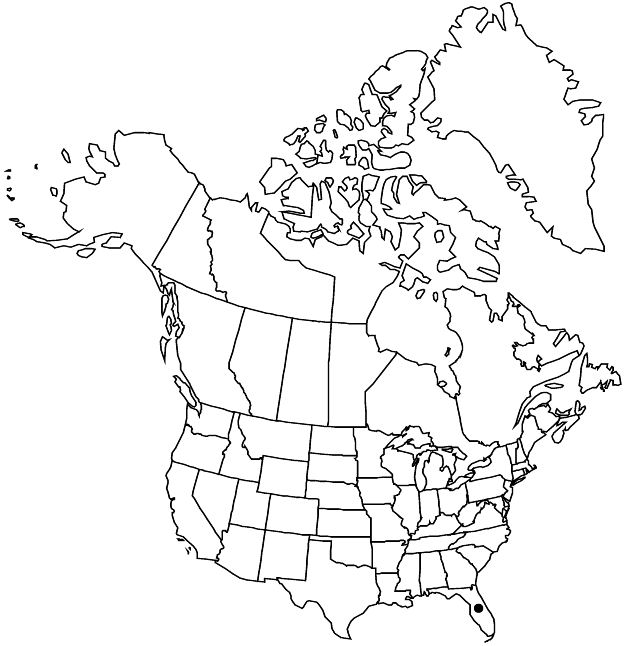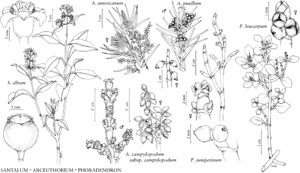Santalum album
Sp. Pl. 2: 349. 1753.
Trees, 4–9 m, upright or clambering, sprawling among other vegetation; branches slightly angular-striate. Leaves: petiole 2-ribbed, 1–1.8 cm; blade ovate to lanceolate-elliptic, 3.5–6 × 1.1–2.3 cm, apex obtuse or acute, adaxial surface shiny, darker green than abaxial surface; venation brochidodromous. Inflorescences: peduncles 4–11 mm. Pedicels to 1 mm. Flowers 3–4 mm; petals turning rose to crimson red or maroon through maturation, reflexed, triangular, 2 mm, post-staminal hairs white, long, coarse; nectary lobes reddish, ovate, prominent; stamens situated between nectary lobes; filaments longer than anther, positioning anthers above nectary lobes at height of stigma; styles 2 mm. Pseudodrupes nearly spheric, 7 × 8 mm, borne on short peduncle, often 1 per dichasium; epicarp dark red to black, mesocarp smooth. Seeds spheric. 2n = 20.
Phenology: Flowering Jul–Dec, fruiting Jul–Dec.
Habitat: Overgrown pine rocklands.
Elevation: 0 m.
Distribution

Introduced; Fla., Asia (Indonesia), also elsewhere in Asia (India), Australia
Discussion
Santalum album has long been cultivated for its fragrant wood, and its oil is used as incense and perfume, and for various cosmetic and medicinal purposes (L. Hamilton and C. E. Conrad 1990).
Santalum album was introduced into cultivation after 1920 at the USDA Chapman Field Subtropical Horticulture Research Station in Miami-Dade County, Florida. The first collections documenting its escape from cultivation were made in 1989 and 1991 at that location. Later collections indicate that the species is common along the edges of a pine rockland remnant, thus indicating that a small colony had become established. An additional plant was also seen at the Deering Estate at Cutler (a county preserve) near Chapman Field (R. P. Wunderlin, pers. comm.). Given that flowers and fruits are present on vouchered specimens, S. album appears to be reproducing and spreading via its bird-dispersed fruits and seeds. This introduction demonstrates that sandalwood is not host specific, as none of its North American hosts in Florida are found within its natural range.
Santalum album is exceptional in the genus by having the ovary often appearing nearly superior. The ovaries in the remaining species of Santalum are half-inferior or more.
Selected References
None.
